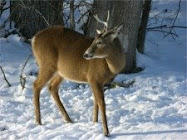Deer Hunting Tips
If you hunt woods or transition habitat that deer traverse to move from feeding to bedding areas in the morning, stand-hunting for the first couple of hours of daylight can be effective. The biggest bucks are often skulking back toward their bedding cover at that time, or trying to catch the scent of an estrous doe. The best deer hunting tip is sitting immobile because this is a deadly method.
Locate rub lines leading into these thick areas that the deer are using as bedding areas and set your ambush between the food source and the bedding area. Allot of bucks follow patterns from previous years, with the main idea being identifying where these rub lines are leading to and from.
Deer will frequent areas with a “buffer zone” between the bedding and the feeding areas. This area can be a 30 yard wide strip of overgrowth or a dry creek bottom. They will use this as a staging area from which they will stop before/after feeding and will become a great place for them to chase does in the ensuing rut.
Once you determine a pattern that the deer are using, you can put technology to work for you in the form of a trail camera. These are excellent tools for scouting an area without having to physically be present, and can give you a better idea of what kind of deer are using the area, and when.
In smaller areas, driving may hurt your chances for stand-hunting and still-hunting later, so it'd be better to skip this approach. On the other hand, if you have access to lots of land or can drive-hunt another area, one where your stands aren't placed, then this can be a valuable way to spend the midday hours.
The best way to assess this is to just use common sense. If you're hunting a remote area, it's not good to sweat before walking through a bedding area to hunt the same stand for the sixth day in a row. But if loggers have been cutting in the area for the last month, odds are your truck won't bother the deer much.
Often the wisest old bucks move freely from midmorning until midafternoon, sensing that most hunters are in camp then. Sitting on stand for those hours can yield some of the biggest bucks of the season - particularly if the rut or secondary rut is in progress.
You will not bag a trophy buck by using standard techniques like everyone else. In fact, it probably does not matter if there are big bucks in the area you hunt. The truth is that if you're using all the normal tactics you will not get the monster. The really BIG bucks are old bucks. They do not grow old by falling prey to the normal tactics the majority of hunters use.
You will find that big bucks will frequently have wet feet. Yep - find areas where there is a creek bottom or lowland wet areas such as a swamp and other wetlands. Talk to the experienced hunters who have shot big bucks. They like the thick cover the wetlands produce because it gives them security. Also, deer are excellent swimmers. It is nothing for them to swim major rivers, let alone creeks and lakes. When pressure increases the big bucks head for cover.
Don VandeBergh, a biologist with the Oregon Department of Fish and Wildlife, has been keeping an eye on local deer herds in northwest Oregon. According to VandeBergh, the Trask Unit has seen some of the same disease issues that have affected deer herds on the central coast. Best bets will be on timber company land and at higher elevations.
Keeping an open mind and choosing your strategy each day, and even each hour, based on what is most appropriate for the given conditions is especially important if you're still looking to bag a buck well into the season, or if you have a second or third tag to fill. Things get tougher as the season goes on, and being flexible can pay off.
He better think again because many times the parade is only about to begin, and you will wonder where did that buck ever come from?? Most hunters will leave their position to soon bucks who have traveled past the blind may turn around and come down the same trail past the blind the same morning or afternoon.
As the winter snows thaw and the dogwoods begin to bloom, many deer hunters turn their attention to other endeavors. Things like turkey hunting, fishing, or working on that growing honey-do list can all push deer season to the back of a hunter's mind. For those of you serious about your deer hunting, however, there are still plenty of things that can be done to help increase your odds of scoring on a big buck come fall.
Lastly, be still and patient. Don't be one of these hunters who can't sit in one place and always thinks the deer is over the next hill. Most deer are killed by hunters who sit still, watching and waiting.
By the first of the year, deer season is winding down across the country, and many hunters pack up their gear and kick back in front of the television to watch reruns on the Outdoor Channel. For the serious hunter, however, this is no time to rest!
Follow these deer hunting tips for success this deer season!
